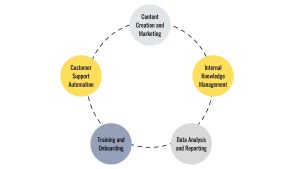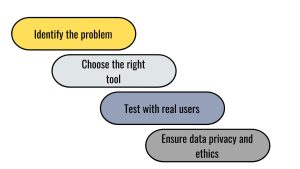LLMs in Business: What They Are and How to Use Them
Introduction Big Language Models, or LLMs, are no longer just buzzwords in the tech world. They are practical tools that are changing the way companies operate, communicate, a...

Introduction
Big Language Models, or LLMs, are no longer just buzzwords in the tech world. They are practical tools that are changing the way companies operate, communicate, and serve customers. From startups to enterprises, companies are beginning to realize the enormous potential these models offer.
But what exactly is an LLM? And how can LLMs help your business grow, adapt, and thrive? Let’s find out.
What Is a Large Language Model?
A large language model is a type of artificial intelligence trained to understand and generate human language. It reads huge amounts of text – books, websites, documents – and learns the patterns, meanings, and structures of the language.
Think of it as a super-smart assistant that can read, write, summarize, translate, encode, and even brainstorm ideas. Models like OpenAI’s GPT-4, Google’s Gemini, or Meta’s LLaMA are just a few examples making headlines today. These models aren’t just intelligent – they’re incredibly versatile.

Why Businesses Are Paying Attention
Business runs on communication. Whether it’s emails, customer support, reports, marketing content, or internal documentation, clear language is at the core. That’s where LLMs shine.
But beyond words, LLMs bring speed, consistency, and a unique kind of intelligence. They can analyze data, automate tasks, and even offer strategic insights – at scale.
In today’s fast-paced environment, that’s a serious advantage.
Key Use Cases of LLMs in Business
Let’s take a look at how companies are already using LLMs in a meaningful way.
1. Customer Support Automation
LLMs can power chatbots and virtual agents that understand customer queries and respond naturally. Unlike traditional bots with canned responses, LLMs offer flexible, human-like responses.
This reduces response times and increases satisfaction. Plus, your support team can focus on more complex issues.
2. Content Creation and Marketing
Struggling with blog posts, product descriptions, or ad copy? LLMs can generate fresh, creative content in seconds. You can use them to brainstorm campaign ideas, rewrite content for different audiences, or optimize SEO keywords. It’s like having a team of writers on standby 24/7.
3. Internal Knowledge Management
Employees often waste time searching for information buried in documents or tools. LLMs can act as intelligent search assistants. Ask a question in plain language – “How do I apply for travel reimbursement?” – and get a clear answer immediately. No more digging through endless files.
4. Data Analysis and Reporting
Inputting raw data into an LLM can help create easy-to-understand dashboards, charts, or even strategic recommendations. This bridges the gap between data and decision making, especially for non-technical teams. This means faster insights, smarter choices.
5. Training and Onboarding
New employees often have a long list of questions. Instead of overwhelming managers, an LLM can act as a real-time training assistant. It can explain processes, policies, and tools – without the wait. This makes onboarding smoother and more consistent.

How to Start Using LLMs in Your Business
You don’t have to be a tech giant to benefit. Getting started is easier than you think.
Step 1: Identify the problem
Start with a clear use case. Want to improve customer support? Speed up content creation? Help your team find information faster?
Start small. Pick a repetitive, complex language task.
Step 2: Choose the right tool
There are many LLM-based platforms on the market. Tools like ChatGPT, Jasper, or Claude are plug-and-play. For more customized solutions, you can consider integrating LLM via API.
Don’t worry – you don’t need to build one from scratch.
Step 3: Test with real users
Launch the tool with a small group first. Monitor how it works. Collect feedback. Tweak and improve as you go. LLMs learn from context, so providing clear instructions and examples can improve their responses.
It’s not about being perfect from day one, it’s about learning and improving.
Step 4: Ensure data privacy and ethics
LLMs are powerful people, but they need to be handled with care. Make sure all the data you use is secure. Don’t submit sensitive information to publicly available tools without checking compliance guidelines.
Also, always review the output. LLMs can sometimes “hallucinate” or make up facts. Human oversight is key.

Common Myths About LLMs
Let’s clear up a few misconceptions.
- “They will replace people.”
Not true. LLMs are tools, not replacements. They work best when they support human teams, not replace them.
- “They are only for large companies.”
Wrong again. Many LLM tools are affordable and scalable. Small businesses are using them right now to gain an edge.
- “They are too complicated.”
Most LLM tools are user-friendly. If you can use a chat box, you can use an LLM.

What the Future Looks Like
As LLMs continue to evolve, expect them to become even more accurate, faster, and easier to integrate. Companies that are implementing them now aren’t just keeping up with the times – they’re moving forward.
In the future, we may see LLMs helping with strategy, forecasting trends, or even leading innovation.
The key is to stay curious and open to change.
Conclusion
Big language models are here – and they’re transforming the way we work. From improving communication to streamlining operations, the possibilities are huge.
You don’t have to dive in head first. Start with one problem, one tool, one small step. Experiment. Learn. Grow. Soon enough, you’ll wonder how you ever worked without them.